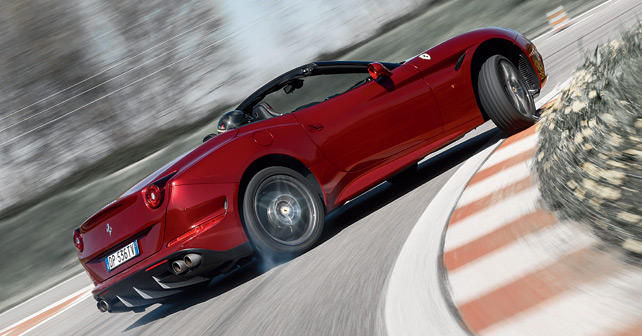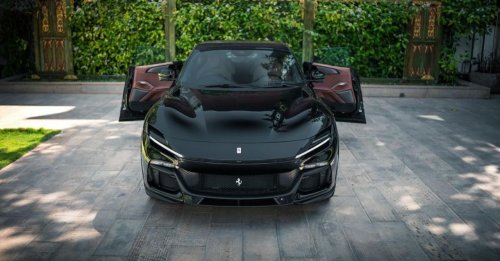A Prancing Horse on the hood always guarantees excitement. And now that this hardtop convertible from Maranello is turbocharged, it’s stronger than ever. What’s more, this is a Ferrari for everyday use.
The California T is Ferrari’s return to forced induction. It doesn’t have the ferocity of a 458 Italia, nor the ruthlessness of an F12 Berlinetta. It’s the softest in the Ferrari range, designed for daily use. Nevertheless, powered by a 552bhp, 3.9 litre V8, mated to a seven-speed dual-clutch auto, it’s plenty quick and agile – as a Ferrari is meant to be. The folding roof tucks into the top half of the trunk – and while technically the T is a four-seater, the rear is better suited for luggage.
THE TURBO IS BACK
In its revised version, the California T’s styling has been tweaked – with practically everything receiving changes, except the roof. The entire body has been updated, and the California is a bit more modern. The changes in the interior, however, have been less drastic. The indicators and wipers are now controlled from the steering wheel – and the Turbo Performance Engineer screen, which keeps an eye on boost pressure, has been placed in the central console. The response and efficiency is the real novelty of the California, which justifies the ‘T’ in its name.
The T, of course, stands for ‘turbocharged.’ Now, Ferraris are meant to rev stratospherically. But after 30 years of high revving engines, even in Maranello they’ve been forced to downsize. The very slender hood now contains something completely new and different. It’s still a flat plane V8, with displacement reduced by 400cc, with a pair of turbos added – just enough to get to 552bhp and achieve uncompromising results in terms of performance.
In spite of being a cleaner and more eco-friendly car, the California pushes the envelope in every respect. The direct injection is there to give the car immediate throttle response – even before the imperceptible turbines take over in a progressive manner. There is simply no delay in response, or sudden increase in thrust as the revs rise – thanks, in part, due to the way the torque is handled. It has a different peak for each gear – an engineering ingenuity that they’ve honed at Maranello. But in terms of emotional appeal, something has been lost – details, nuances, and the old V8, with its normally aspirated 8,000rpm redline, had a capacity to engage still higher.
SHARPNESS IS THE KEY
And what’s lacking can’t just be attributed to the 500 fewer revolutions of the engine at the redline. The lure of its soundtrack – screaming, acute and lacerating, fuelled the unstoppable desire to take the old V8 to the redline. Those adjectives fit the new California T a little less, because its exhaust note is more ‘baritone.’ In any case, the new engine helps honing the handling qualities. You see, it’s mounted 30mm lower – and that’s something that shouldn’t be underestimated. It’s now also paired with a more direct steering system, so that the California is sharper than what you remember it to be. And so the lap time at the Vairano circuit is improved by almost three seconds.
With its roof open (which takes 14 seconds to go from closed to open, and vice versa), the symphony of the V8 is an invitation to pick up the pace. The California is already irresistible when changing around 2,500-3,000rpm – with the double clutch that rattles off the gears instantly. It stays flat while cornering, with a front end that never refuses to take the intended line and a rear that firmly follows the orders given by the front wheels. And it’s only when you really start to push that the roll becomes barely noticeable – nothing that jeopardizes the handling or precision though. These body movements, in fact, become a valuable source of information for interpreting the behaviour of the car – and avoiding any unexpected reactions. Indeed, it’s when you pay attention to the transfer of weight, and use it to your advantage, that the California gives all of itself to the person who’s fortunate to find him or herself in the drivers’ seat. Corner-after-corner, the confidence becomes complete and only one mystery remains – how can this Ferrari have tipped the scales at just under 1,900 kilograms? Judging by its response and handling, you’d guess that it weighs at least 200kgs less than its predecessor.
SEIZING THE MOMENT
THREE CHARACTERS AT A SWITCH
To truly understand the differences in the three settings of the Manettino, we put them up against one another. Right from the start, it’s evident that the differences between Comfort and Sport aren’t stark. This demonstrates the excellent calibration of the safety systems.
VARIABLE TORQUE
The reduction from 4.3 to 3.8 litres, and the adoption of twin-turbos, led to a total reworking of the engine layout. Working on the lubrication, distribution, intake and exhaust, Maranello’s engineers have managed to redraw a turbocharged V8 that is a bit wider, but substantially lower in height than the previous one (55mm less), which allows it to be placed further down in the engine bay. The new eight-cylinder engine retains the flat plane crankshaft, which cranks to 180°, and is direct injection with a pressure of 200 bar – while the compression ratio, as it’s a turbocharged unit, is reduced from 12.5 to 9.5:1. The exhaust manifolds have been optimized, so as to minimize the response time. The maximum boost pressure, and, consequently, the available torque varies according to the gear used. As seen in the chart below, the peak torque is 615Nm at 5,750rpm in the first three gears. In the sixth gear, instead, we have over 650Nm practically constant between 2,500 and 5,500rpm. Only in the seventh gear will you reach the maximum torque figure of 755Nm. In this case, the maximum power of 552bhp is delivered at 6,000rpm.
SPECIFICATIONS
Engine
• Front longitudinal, petrol
• 8 cylinder V (90°)
• Bore 86.5mm
• Stroke 82.0mm
• Displacement 3,855cc
• Max power 552bhp at 7,500rpm
• Max torque 755Nm at 4,750rpm (VII)
• Cylinder block and heads of light alloy
• 2-axis overhead cam per bank, 32valves (chain)
• Direct injection, twin-turbo and 2 intercoolers
Transmission
• Rear-wheel drive
• 7-speed double-clutch gearbox
• Auto-locking differential
Tyres
• Front 245/40ZR19
• Rear 285/40ZR19
Body
• Coupe spider, 2-door, 2+2seats
• Front axle wishbone, coil springs, stabilizer bar
• Rear axle multilink, coil springs, stabilizer bar
• Hydraulic shock absorbers, electronic control
• Ventilated carbon-ceramic disc brakes (front 390mm, rear 360mm), and ABS, ESP.
• Speed sensitive power steering, hydraulic power steering
• Fuel Tank 78 litres
Dimensions and mass
• Wheelbase: 2,670mm
• Track: front 1,631mm, rear 1,605mm
• Length: 4,569mm
• Width: 1,910mm
• Mass: 1,730kgs
Produced in
• Maranello (MO) ITALY
THE GOOD
Performance: The new V8 is very strong, and, combined with the amazing double clu tch gearbox, ensures numbers that are beyond the realm of an ordinary touring machine.
Versatility: The soul of a Ferrari, with the ease of use of an everyday machine.
THE BAD
Limited Manettino modes: We would have liked more positions than the three available – for instance, a position between Sport and ESC-Off.
Barely legible speedometer: The analogue speedo on the right has a typeface that’s too large, while the digital display to the left is too small.
CONCLUSION
In Maranello, the turbo has arrived. Or, rather, the modern turbo – because we’ve already seen a lot of turbocharged Ferrari’s. The most famous ones from 30 years ago, like the 288 GTO and F40, have become pure legends. However, the story is quite different now. Even if you put the Ferrari nameplate on a car, and produce less than 7,000 cars a year, you can’t afford to ignore issues such as reducing fuel consumption and emissions.
The solution, however, couldn’t just be a simple case of downsizing. And so Ferrari had to delve into the details of the California, and improve everything from design, the interior, the mechanicals, and virtually everything other than the existing roof mechanism. The result is considerable improvement, which has made the California more effective without shifting the focus of its personality. It remains a cross between a miraculous touring machine, as easy going as any other, and a sports car that exhibits the typical traits of the black “Cavallino” on a yellow shield. We just have to accept the fact that the turbo has dulled the unmistakable soundtrack a little. But that’s only a problem that affects old-time customers of the brand – as they are the only ones who can distinguish between subtleties like that. For everyone else, it’s virtually impossible to notice the difference.
© Riproduzione riservata













































Write your Comment